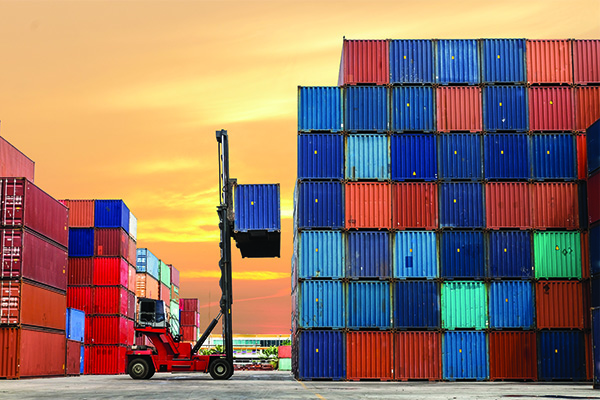United States-bound retail container imports are starting to get caught up to the months-long run stretch of backlogs, while the possibility of a summer surge looms, according to the most recent edition of the Port Tracker report, which was issued today by the National Retail Federation (NRF) and maritime consultancy Hackett Associates.
The ports surveyed in the report include: Los Angeles/Long Beach; Oakland; Tacoma; Seattle; Houston; New York/New Jersey; Hampton Roads; Charleston, and Savannah; Miami; Jacksonville; and Fort Lauderdale, Fla.-based Port Everglades.
Authors of the report explained that cargo import numbers do not correlate directly with retail sales or employment because they count only the number of cargo containers brought into the country, not the value of the merchandise inside them, adding that the amount of merchandise imported provides a rough barometer of retailers’ expectations.
“As we entered 2022, the biggest question was when the supply chain would return to normal,” NRF Vice President for Supply Chain and Customs Policy Jonathan Gold said in a statement. “Unfortunately, we still don’t have a definitive answer. Congestion at West Coast ports has eased, but congestion at some East Coast ports is growing. Ports aren’t as overwhelmed as they were a year ago, but they are still significantly busy moving near-record volumes of cargo.”
For February, the most recent month for which data is available, import volume—at 2.11 million TEU (Twenty-Foot Equivalent Units)—was off 2.3% compared to January and up 13% annually.
For the following months, Port Tracker issued the following projections:
- March, at 2.27 million TEU, matching March 2021;
- April, at 2.13 million TEU, down 1.1% annually;
- May, at 2.21 million TEU, down 5.3% annually;
- June, at 2.26 million TEU, up 5.2% annually;
- July, at 2.32 million TEU, up 5.6% annually; and
- August, at 2.35 million TEU, up 3.3% annually, which would represent a new record for the number of containers imported in a single month going back to 2002, when NRF first started tracking imports (the current record is 2.33 million TEU set in May 2021)
- Port Tracker pegged the first six months of 2022 to come in at 13.1 million TEU, which would mark a 2.5% annual gain.
In a recent interview with LM, NRF’s Gold explained that consumer demand remains high and continues to drive solid import volumes.
“Throughout the pandemic, we have seen a $1 trillion swing, in consumer spending, from services to goods,” he said. “The consumer is still out there purchasing online or in store as things open up again and will continue to do more and more of that. I think consumers are looking to spend more on services now that all of the mask mandates are gone and things are opening back up. But inflation and gas prices are a factor, too.”
As for Port Tracker data in the coming months, he said that gains are expected but not to the same extent in 2021, which often saw double-digit increases, related to more moderate annual comparisons.
Hackett Associates Founder Ben Hackett wrote in the report that the number of ships waiting to unload at Los Angeles and Long Beach has dropped significantly, with relatively few waiting for long periods and most being smaller vessels under 10,000 TEU capacity.
“Given the virtual shutdown of Shanghai for COVID-19 testing and the sharp drop in export production as a result, there are now several large vessels waiting to enter the port there to discharge empty containers and load export boxes,” he added. “The wait on that side of the Pacific will help reduce the pressure of vessel arrivals at Los Angeles-area terminals. Our projection is that throughput on the West Coast will remain stable to strong through most of April. The reduction in COVID in the United States is also helping ease the strain on the transportation supply chain.
He also observed that given the recent COVID-19 lockdowns, a main concern he has is that the supply of goods from China will decline as it did in 2020, adding that shipping capacity remains stable and sufficient, and is expected to increase as congestion in China and along the US coasts slow.
SC
MR


Latest Supply Chain News
- Despite American political environment, global geopolitical risks may be easing
- Joseph Esteves named CEO of SGS Maine Pointe
- Employees, employers hold divergent views on upskilling the workforce
- April manufacturing output slides after growing in March
- Q1 sees a solid finish with positive U.S.-bound import growth, notes S&P Global Market Intelligence
- More News
Latest Podcast

 Explore
Explore
Latest Supply Chain News
- Despite American political environment, global geopolitical risks may be easing
- Joseph Esteves named CEO of SGS Maine Pointe
- Employees, employers hold divergent views on upskilling the workforce
- April manufacturing output slides after growing in March
- Q1 sees a solid finish with positive U.S.-bound import growth, notes S&P Global Market Intelligence
- World Trade Centers offers a helping hand to create resilient, interconnected supply chains
- More latest news
Latest Resources

Subscribe

Supply Chain Management Review delivers the best industry content.

Editors’ Picks




